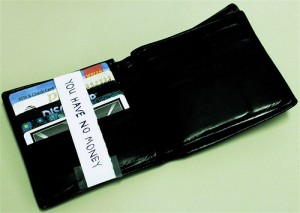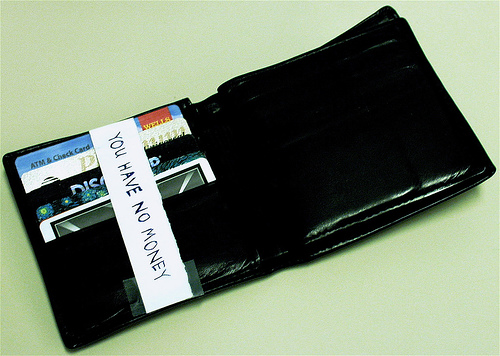- Up at 5 two days in a row. Sleepy. #
- May your…year be filled w/ magic and dreams and good madness. I hope you…kiss someone who thinks you’re wonderful. @neilhimself #
- Woo! First all-cash grocery trip ever. Felt neat. #
- I accidentally took a 3 hour nap yesterday, so I had a hard time sleeping. 5am is difficult. #
- Wee! Got included in the Carnival of Personal Finance, again. http://su.pr/2AKnDB #
- Son’s wrestling season starts in two days. My next 3 months just got hectic. #
- RT @Moneymonk: A real emergency is something that threatens your survival, not just your desire to be comfortable -David Bach # [Read more…] about Twitter Weekly Updates for 2010-01-09
Free Tivo

- Image by Marcin Wichary via Flickr
TV is causing problems in my life.
We watch too much TV. Often, we’re only watching because there’s a crappy show in between two shows we do want to watch. In the winter–during the new seasons–my son has wrestling practice 4 or 5 nights per week, which means I miss the new shows I like. We recently downgraded our service provider, so there’s no functional guide button in the house.
That all makes me sad.
Then I found out that Tivo’s lifetime service is attached to the unit. If you sell a unit with lifetime service, you can transfer the service to the buyer. You can’t, however, transfer the service to a new box. That means that everyone who upgrades and sells their old box is selling the lifetime service with it. If you don’t mind having older equipment, you can pick up a used box with full lifetime service for less than the cost of a new box.
After reading Erica’s method of finding 750 extra hours per year, we decided to give it a shot. We are taking back control of our TV. No more rushing home to catch a new episode. No more mindlessly channel-surfing to kill time between good shows. No more commercials. And a guide! I like having a guide button.
I started shopping. My goal was to get a Series 2 Tivo with full lifetime service for about $100 before shipping. I came close a few times, but always lost the auction, in the end. I wasn’t in a hurry, and I didn’t actually have the money budgeted, so it was good to lose.
Then, a friend found himself in a situation that didn’t work with a Tivo and decided to sell his heavily upgraded, heavily accessorized Tivo HD for $100 + shipping. A quick call to my wife resulted in just one objection: Where were we getting the money? We don’t have an opportunity fund, yet and I needed to take advantage of this quick if we were going to get it.
I decided to make it free.
When I automated all of our bills, I rounded up. If a bill was for $63.50, I paid $64. If a bill wasn’t exactly consistent, I paid enough to cover the higher amount. For example, I didn’t have a text messaging plan on my cell phone until December. Before that, I’d get about a dozen texts each month, so I budgeted for paying for the texts. If I didn’t get the texts, I’d get a credit on my bill. I never lowered the automated payment. All of my bills were set up like that. My insurance company dropped my rates, but I left the payment alone. I slowly started accumulating a credit on a number of bills. My intention was to skip a month when the billed amount got to $0, and apply the money to debt. It was just a mind-game to play with myself to make the debt easier to pay.
I flipped through the bills, looking at the credits. I adjusted the payments to match the bills this month and found more than enough to buy the Tivo. This is a purchase that doesn’t influence my budget in any way. Almost. This unit doesn’t have lifetime service, so I will be paying for the monthly fee, but that’s been more than balanced out by reducing our television service.
This is a recently-high-end model for free, as far as my budget is concerned. I used money that wasn’t even on the table before I went looking for it. It’s like searching the couch cushions for money to catch a movie.
Now, I’ll have control of my TV–with a strong measure of convenience to boot–for $13 per month. The time savings is yet-to-be-determined.
A free Tivo simply because I rounded my bills up when I automated last year. That’s a pain-free opportunity fund.
Update: After I wrote this, I found out that I dropped the ball in budgeting for child-care now that summer is here and my oldest won’t be in school. These costs are going up $350 per month. I spent an hour scavenging the couch cushions of my budget this week. I had to adjust some savings and repayment goals, but I’ve effectively paid for a summer worth of care for my boy the same way. Free.
My Financial Plan – How I Improve on Ramsey
In April, my wife and I decided that debt was done. We have hopefully closed that chapter in our lives. I borrowed, then purchased, The Total Money Makeover by Dave Ramsey.  budget” width=”300″ height=”213″ />We are almost following his baby steps. Our credit has always been spectacular, but we used it a lot. Our financial plan is Dave Ramsey’s The Total Money Makeover, with some adjustments.
budget” width=”300″ height=”213″ />We are almost following his baby steps. Our credit has always been spectacular, but we used it a lot. Our financial plan is Dave Ramsey’s The Total Money Makeover, with some adjustments.
Step 1. Budget:
The budget was painful, and for the first couple of months, impossible. We had no idea what bills were coming due. There were quarterly payments for the garbage bill and annual payments for the auto club. It was all a surprise. Surprises are setbacks in a budget.
When something came up, we’d start budgeting for it, but stuff kept coming up. We’re not on top of all of it, yet, but we are so much closer. We’ve got a virtual envelope system for groceries, auto maintenance, baby needs(we have two in diapers) and some discretionary money. We set aside money for everything that isn’t a monthly expense, and have a line item for everything that is. My wife is eligible for overtime and monthly bonuses. That money does not get budgeted. It’s all extra and goes straight on to debt, or to play catch-up with the bills we had previously missed. I figure it will take a full year to get all of the non-monthly expenses in the budget and caught up.
Step 2. The initial emergency fund:
Ramsey recommends $1000, adjusted for your situation. I decided $1000 wasn’t enough. That isn’t even a month’s worth of expenses. We settled on $1800, plus $25/month. It’s still not enough, but it’s better. Hopefully, we’ll be able to ignore it long enough that the $25/month accrues to something worthwhile.
Step 3. The Debt Snowball:
This is the controversial bad math. Pay off the lowest balance accounts first, then take those payments and apply them to the higher balance accounts. Emotionally, it’s been wonderful. We paid off the first credit card in a couple of weeks, followed 6 weeks later by my student loan. Since April, we’ve dropped nearly $10,000 and we haven’t made huge cuts to our standard of living. At least monthly, we re-examine our expenses to see what else can be cut.
Step 4. Three to six months of expenses in savings:
We aren’t on this step yet. In step 2, we are consistently depositing more, making us more secure every month.
Step 5. Invest 15% of household income into Roth IRAs and pre-tax retirement:
I have not stopped my auto-deposited contribution. It’s stupid to pass up an employer match. My wife’s company does not match, so she is currently not contributing.
Step 6. College funding for children:
We have started a $10 College fund.
Step 7. Pay off home early:
I don’t see the point in handling this one separately. Our mortgage is debt, and when the other debts are paid, we will be less than a year from owning our house, free and clear. This is rolled in with step three. All debt is going away, immediately.
Step 8. Build wealth and give!
We have cut off most of our charitable giving. Every other year, it has been a significant percent of our income, and in a few more years, will be so again. The only exception to this is children knocking on the door for fundraisers. I have no problems with saying no to a parent fundraising for their kid, but when the kids is doing the work, door-to-door, especially in the winter, I buy something. My son’s school, on the other hand, gets fundraisers ignored. When they come home, I send a check to the school, ignoring the program. I bypass the overhead and make a direct donation.
Apple Launches iPad Air in November

With a lighter and thinner chasis, the newly announced iPad Air has a more powerful processor with a great new design and performance features that’s sure to continue Apple’s trend setting reputation. Apple senior vice president Phil Schiller is calling it the biggest leap forward for a full-sized iPad. We expect people have already started packing overnight bags for their long wait on the sidewalks outside the stores.
With almost a half million apps already available for the iPad, you have a great head start on things to do. Apps built into the iPad Air will include solutions for routine tasks, like web surfing and checking email. A number of previously apps that had to be purchased are now free, such as iMovie, Keynote, iPhoto, GarageBand and Pages. Popular apps for other Apple products, they have all been upgraded to work with iOS 7 and the iPad. Quickly put together an original song or detail a presentation anywhere. As a lot of apps are developed solely for Apple products, these can look stunning on their displays.
The iPad Air’s current launch date is November 1. It will come in black and gray or silver and white. It will start at $499 for a 16 gigabyte WiFi version. This is $100 more than previous generation launches, but supporters say the consumer is getting more screen real estate. The Cellular model will retail for $629. The iPad 2 will continue in the stores for $399.
Related articles
How Banks Work
On the first and the fifteenth of every month, my paycheck is deposited into my bank account. Some fraction of it is saved, while another(larger) fraction is spent. They put the money in a vault and protect it from being stolen. Anything I manage to save and anything I haven’t managed to spend yet, will build interest. The bank pays me to keep my money there, even if it’s just for a short time. Why would they do that? If I asked you to hold on to $100 for me, in exchange for giving me $10 next week, you’d laugh at me. Right? If I told you that I was expecting you to keep that $100 heavily guarded in a locked room that requires a staff and utilities, you’d try to have me committed, yet that’s what banks do every day.
What’s in it for the bank?
Let’s start at the beginning. In the financial world, there are fundamentally two types of people: those who have money and those who need it.
The people who have money get it by producing something or otherwise providing value to someone for something. They then spend less than they made, leading to an accumulation of money. Woo! Rich people! Naturally, this money gets stuffed in a mattress for safe-keeping. Their money does nothing except collect dust and, occasionally, hungry insects. It is also used to soften a hard mattress.
People who need money have a few choices. They can beg for it, work for it, or steal it. The third option leads to perforation or imprisonment, so we won’t address that one. Now, you can work for your paycheck, like most adults, or you can go, hat in hand, to a charity and ask for money. But what if you want to start a business? You’ve invented the super-widget, a device guaranteed to revolutionize the world more than anything since sliced bread or the USB-powered pet rock. You got a concept and a prototype, you just don’t have the tooling or manpower to produce the millions of super-widgets the world will soon be beating a path to your door to own. You also lack a marketing budget to tell the world to stock up on path-beaters to make it to your door. What do you do?
Enter banks.
A bank will approach the first class of people and talk their money out of the mattresses and mayonnaise jars. They offer to hold the money for the people who have it. They will protect it from theft and they will pay the owner a fee for the privilege of holding on to the cash safely. Of course savers jump at the chance. They can quit worrying about the maid making the bed and becoming a millionaire and they can build wealth with no work. But wait…TANSTAAFL, right? You can’t get something for nothing. The world doesn’t work that way.
The bank takes your money–and the money of thousands of people like you–for safe-keeping. They pay you a fee, called interest. The rest, the loan out to the second group of people, the ones who need the money. They set aside some of the deposits so the owners can make withdrawals, but the rest goes into the loan-pool. People who need money come to the bank, explain their needs and demonstrate their ability to repay the loan, then they are given money for a fee, also called interest. The interest rate for the borrower is significantly higher–sometimes 20 times higher–than the interest paid to depositors. The difference between interest earned and interest paid is what pays the bank’s bills. That gap pays for the rent, taxes, and payroll.
Ultimately, a bank’s job is to connect the savers with the spenders in a way that’s reliable enough to ensure everybody benefits. If anybody in the chain ceases to benefit, the system collapses. Depositors switch back to using mattresses, borrowers go back to their loan-shark grandparents, and banks close their doors. This is the system that allows the entrepreneurial spirit to thrive, while making money for everyone involved.
Saving Money: The Warranty Fund
Last weekend, my DVD player died.
No big deal, right? We watch a lot of movies. We get a lot of enjoyment out of watching a lot of movies. Movies are fun for us. We’ve got a projector and a movie screen in our living room. Movies are our biggest pastime. Naturally, losing the movie machine hurts.
The thing that hurts the most is that this hasn’t been a good month for us, financially. My wife gets paid hourly, with semi-monthly paychecks. This means that, in a short month(like February!), her second paycheck is small by a few hundred dollars. When her company switched to that nonsensical plan, I watched for a few months, then set our budget to match the smallest paycheck she received. They haven’t been using this ridiculous plan for a full year, yet.
February caught me by surprise.
I know, it shouldn’t have. According to my research, there has been a February in every single year since well before I was born. I should have been expecting it. Oops.
So, to recap: our favorite pastime was dead and money was a little bit tight. There was no money to shake out of the budget to cover a new DVD player and there was no way we’d hit our emergency fund for something as frivolous—if enjoyable—as movies.
What to do?
About a year ago, I decided to start a warranty fund. There are things we can’t easily afford to replace, so we pay for warranties on some of them. For example, our cell phones have a repair plan, and that plan has saved us more than it has cost us. We have a repair plan for some of our appliances, and that, too, has saved more than it has cost us. My goal was to self-warranty my stuff. I wanted an account that had money that served no purpoase but to help me avoid paying for warranties.
I set up another ING Direct savings account and scheduled an automatic deposit. It’s only set to deposit $25 per month, but over a year, it was enough to replace our home theater system, with some left over. It is, quite simply, money to use when our stuff breaks.
With no warning, and no time to prepare, we still had enough money socked aside to handle one of life’s little surprises, without wrecking our plans.
How do you prepare to replace the things that are going to break?







